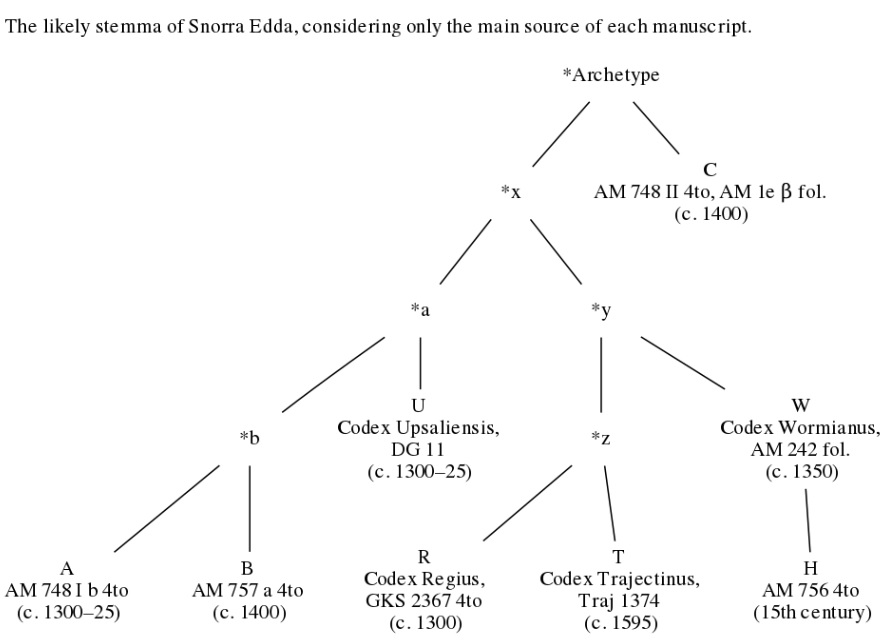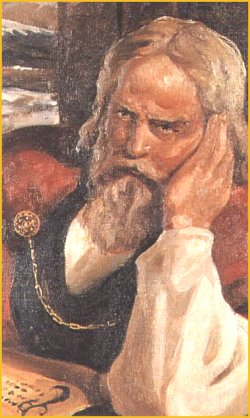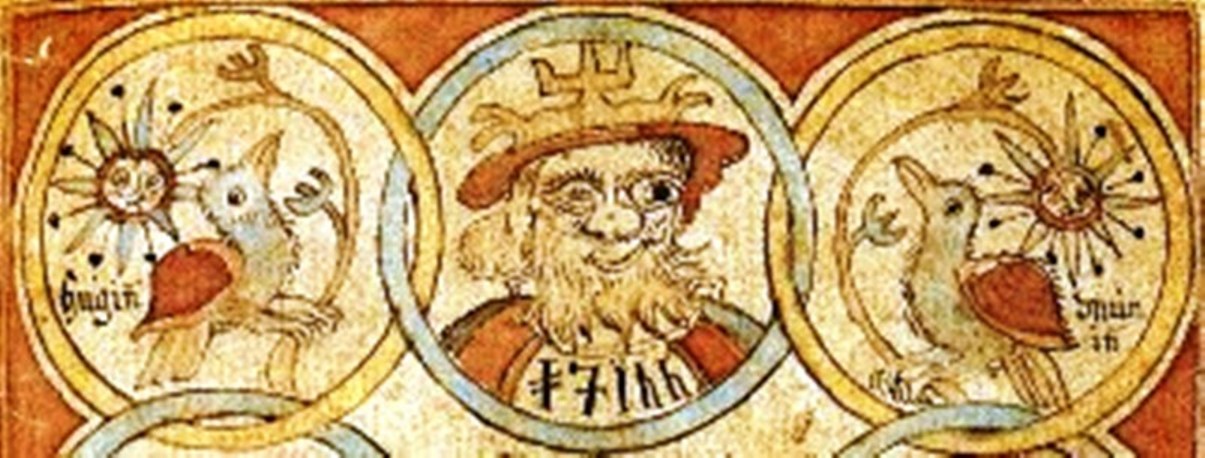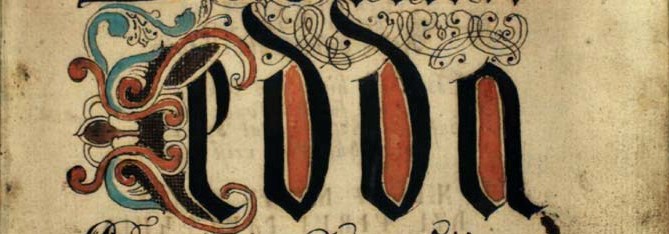CHAPTERS:
[13-16] [17-22] [23-32] [33-37]
[38-43] [44-48] [49-50] [51-54]
English Translations: [Percy 1770], [Dasant 1842], [Anderson 1889], [Broeder 1916]
Codex Upsaliensis [U], Codex Regius [R], Codex Wormianus [W], and Codex Trajectinus [T]
-
[U] The Codex Upsaliensis (DG 11), the oldest surviving manuscript of Snorri's Edda, was composed in the first quarter of the 14th century. It provides some variants that are not found in any of the three other major manuscripts. The attribution of Snorri Sturluson's authorship of the text, as well as the title Gylfaginning for the first chapter, are only found in this manuscript, now held by the library of the University of Uppsala (Sweden).
-
[R] The Codex Regius (GKS 2367 4°), written in the first half of the 14th century, is the most comprehensive of the four manuscripts. Considered to be closest to the original, it is often used as the basis for modern editions and translations of Snorri's Edda. Its name reflects its original catalog number at the Royal Library of Denmark where it resided for several centuries. In 1985, the Codex Regius manuscript was returned to Iceland, where it is now held by the Árni Magnússon Institute for Icelandic Studies in Reykjavík.
-
[W] The Codex Wormianus (AM 242 fol), written in the mid-14th century, contains an extended Prologue to Gylfaginning, longer than the other manuscripts. It remains part of the Arnamagnæan Collection, gathered by Árni Magnússon in Copenhagen.
-
[T] The Codex Trajectinus (MSS 1374), written c. 1600, is a copy of a manuscript that was made in the second half of the thirteenth century. It is kept in the library of the University of Utrecht, Netherlands.
Although some scholars have doubted whether a sound stemma of the manuscripts can be created, because of the possibility of scribes drawing on multiple exemplars or from memory, recent work has found that the main sources of each manuscript can be fairly well ascertained.
 |
 |
The Prose Edda remained relatively unknown outside of Iceland until the publication of the Laufás Edda compiled by the Icelandic priest and poet Magnús Ólafsson (c.1573–1636) at the request of the Icelandic scholar and antiquarian Arngrímur Jónsson. Magnús began his work at Auðkúla in 1607 after he had been dismissed from his office as parish minister, and completed his new redaction during the winter of 1608–09. He would later serve as the parish priest at Laufás in Northern Iceland; as a consequence, his version of Snorri's Edda came to be known as the Laufás-Edda.
In an effort to create an encyclopedic edition of Snorri Sturluson's Edda, the Laufás-Edda is a heavily redacted version of the text. The myths of Gylfaginning are presented as a series of fables (dæmisögur) and a number of kennings from Skáldskaparmál are listed alphabetically by subject. The Háttatal is omitted. The Laufás Edda became the basis for Peder Hansen Resen's Edda Islandorum in 1665, the first printed Edition of the Snorra Edda. Resen's edition was accompanied by a Danish and Latin translation. His work survives in two versions, known as the X version, parts of which survive in his own hand as well as in three manuscript copies, and the Y version (of which the X version is an abbreviation).
The Codex Regius manuscript of the Poetic Edda first came to light in 1642, but was not widely published in translation until the late 1700s. Through Peder Resen's edition, the Laufás-Edda became a popular and convenient reference for poets and antiquarians alike, raising public awareness and interest in Old Norse studies, and generating interest in the old gods and their mythology at the dawn of the modern era. Of the Laufas-Edda, we have nothing in Magnús’s hand, though it survives in whole or in part in over 100 manuscripts dating from the 17th to 20th centuries, with more turning up from time to time. Even after Resen's publication, the Laufas-Edda was frequently copied down, often with additions and expansions of the original.
Magnús Ólafsson’s Laufas-Edda proved to be far more popular than Snorri Sturluson’s Edda in early modern times; the latter survives in comparatively few manuscripts from that era. The Laufa-Edda dominates, not only being used as the foundation of the first printed edition, but also becoming the basis for several other rearrangements and adaptations of it. This abridged, simplified version of Snorri's text introduced Norse mythology to the popular audience in Europe and in America. The first English Edition in 1770 is arranged in the same manner, as a series of disjointed fables, and not fully corrected until the unabridged translation of the Prologue, Gylfaginning and Skaldskaparmal by Arthur G. Broedur in 1918, and the complete translation of the entire Edda, including Hattatal, by Anthony Faulkes in 1988.

Created from material originally posted by Eysteinn Björnsson (c) 2001
[HOME]
